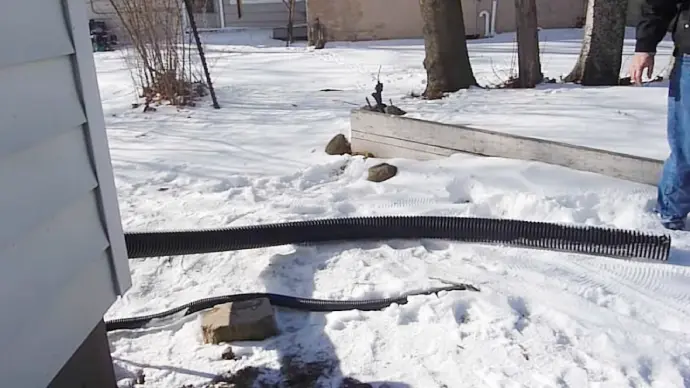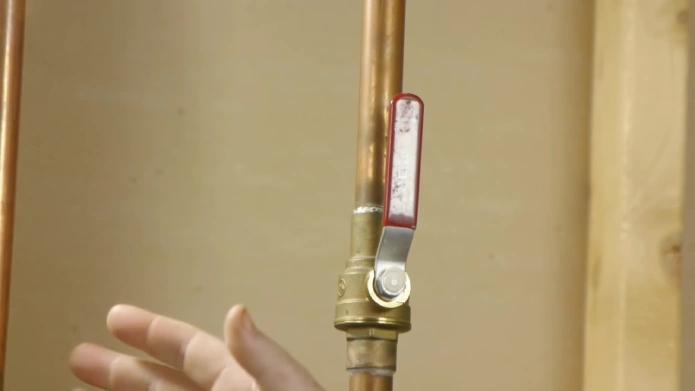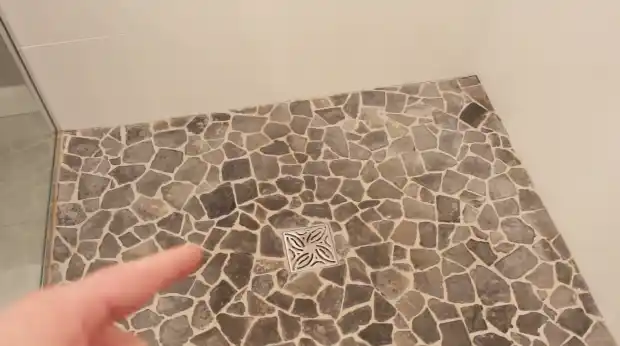Last Updated on May 4, 2023
Despite their importance in keeping basements dry, sump pumps can potentially cause homeowners a great deal of stress. When temperatures drop low enough, the discharge hose is at risk of freezing over and leading to expensive repairs.
To avoid the nightmare of a frozen sump pump hose, there are some important steps that can be taken. Insulating it, allowing a continuous flow of water through it and installing pipes with bigger diameters will help keep your property safe from all kinds of winter woes.
So if you’re looking for ways to safeguard your basement from flooding, read on to learn more about how you can prevent your sump pump hose from freezing.
How to Keep a Sump Pump Hose From Freezing: 7 Ways

Winter can be a treacherous time for homeowners in frigid climates, frozen sump pump hoses create the perfect storm of potentially destructive flooding. Fortunately, there are preventive measures that every homeowner should take to avoid this costly calamity.
ONE: Insulate the Discharge Line
Insulating the discharge line of a sump pump is an effective way to help prevent freezing during cold temperatures. Placing hay, tarps, or other insulating materials around the hose can help retain warmth and reduce the chances of freezing.
Besides that, using a freeze-resistant hose is another option for added protection against cold weather. Also, ensure insulation around the hose is tight and sealed.
TWO: Keep the Water Flowing
The key to preventing hoses from freezing is keeping water moving throughout them. When water collects in sump pump hoses, it creates a higher chance for them to freeze up due to increased contact with cold outdoor temperatures.
To avoid this issue, it’s important to run pumps regularly so that water continues flowing through the hose and prevents freezing from occurring.
THREE: Extend the Hose Away from the House
Keeping the sump pump hose away from a home’s foundation reduces ice buildup on roofs and prevents water from flowing back into the house. The ideal exit point should be placed 10-20ft away from the house and lower than where the pump is.
In cases where more length is needed, adding additional pipes made of insulated or freeze-resistant materials will provide extra security against frozen hoses during winter months.
FOUR: Use a Larger Diameter Pipe
Using pipes of larger diameter than those typically found on most sump pumps helps ensure enough space between them and hoses for air circulation. This keeps both parts warm enough to remain unfrozen when temperatures drop below zero degrees Celsius.
Attaching bigger pipes takes a little more effort (wires and clamps, for example), but it’ll be worth it if you can avoid flooding this winter.
FIVE: Ensure a Straight Discharge Line
A straight sump pump discharge line is essential for ensuring water is quickly expelled from the hose. Installing the discharge line without any dips or curves also helps to reduce the chances of the hose freezing. Connecting a long PVC pipe to the sump pump hose can also help create a straight path.
If a significant curve is necessary, it should be as gradual as possible and installed with enough room around it to ensure proper drainage and airflow.
SIX: Leave a Gap between Buried Pipes
When burying sump pump hoses, it’s essential to leave a gap between them so that water can still flow freely if one of them becomes frozen. It’s best to use bigger pipes to extend hoses and make an air gap big enough to keep the pipes from freezing in extreme temperatures.
It’s also essential to ensure that there is no backpressure on the pipe, as this could cause it to freeze over more quickly.
SEVEN: Use a Discharge Line Cover
A discharge line cover is useful for protecting hoses in extreme temperatures or during heavy snowfall events. It prevents weather damage, such as cracking or splitting due to cold temperatures, while protecting against any clogging caused by snow or ice accumulation inside the pipe.
When a Sump Pump Hose Freezes, What Are the Consequences?

Keeping your sump pump in good condition is key to effectively managing water around the home. However, if a hose gets too cold, it can cause various damaging and expensive problems.
Below are some of the issues that can arise:
Inadequate Drainage: Whenever a sump pump hose freezes, it can block proper drainage. This reduces the amount of water that can be removed from the basement systems leading to flooding and potential water damage to property and belongings.
Reduced Pump Performance: In case a sump pump hose freezes and water cannot flow through the pipe, its performance is greatly reduced because it is unable to take in more water. This means the water level will continue rising until it overflows and causes extensive water damage.
Motor Overheating: When the motor works harder than normal due to inadequate drainage caused by a frozen sump pump hose, it can overheat faster than usual. This can damage the motor permanently as well as reduce the pump’s efficiency.
Hose Got Damaged: In some cases, freezing temperatures may actually end up damaging or cracking the sump pump hose itself. If your sump pump has experienced severe freezing temperatures, you should inspect the hoses for signs of wear and tear before using it again.
Damage To The Pump: If left unattended for too long, a frozen sump pump hose can cause permanent damage to the entire system, including parts like gaskets and seals, impellers, and even corroded pistons within motors.
What Are the Signs That Your Sump Pump Hose is Frozen?
Staying one step ahead of the freezing temperatures can save you a lot of trouble and protect your wallet. Fortunately, several tell-tale signs let you know if a sump pump hose might be on the brink of becoming frozen.
The following are the most common signs:
1. Reduced Water Flow: If your sump pump isn’t pumping out water at its normal rate or if it’s not pumping out any water at all, this could indicate an obstruction that may be due to ice buildup inside the hose.
2. Strange Sounds or Noises: As your sump pump attempts to push water through a frozen hose, you may hear strange sounds like rattling, grinding, or other unusual noises coming from the pump. You may even notice no sound at all coming from your pump if it is completely frozen.
3. Pump Failure: Another sign of a frozen hose is when your sump pump fails to turn on or off correctly. Check the float switch and ensure it isn’t stuck before assuming something is wrong with your sump pump itself. Also, a lack of power going to the sump pump might mean a frozen hose is blocking its water flow.
4. Water in The Sump Pit: If there is an accumulation of water in your sump pit, but none of it is pumped out, then you probably have an issue with a blocked hose due to frost or ice build-up. This could lead to overflow if not addressed quickly enough.
5. Frost or Ice Around The Hose: You probably have a blockage if you see frost or ice around either end of the hose because freezing temperatures cause ice and snow to build up. Any overflowing water can cause serious damage to your house, so clear it out as soon as possible.
6. Strange Odors: If you detect an unpleasant odor near either end of your hose, this could also indicate a problem with a frozen pipe blocking off air circulation. This can cause stagnated water, resulting in odors from bacteria within them.
What Temperatures Can Make a Sump Pump Hose Freeze?

The freezing point of water is 32°F (0°C). This means that when the air temperature around the sump pump drops below freezing, any water inside the discharge pipe will begin to freeze. This is because as temperatures drop, so does the amount of energy available in the environment.
The lower energy level makes it harder for molecules to move about freely and, thus easier to form ice crystals as they become more tightly packed together. Other factors, like wind chill, insulation, and air humidity, can cause a frozen sump pump hose.
Due to their unique weather patterns and overall temperature ranges, different climates can have varying risks regarding possible hosing freezes.
Where Can You Get Top-notch Sump Pump Hose For More Winter Protection?
The best place to find top-notch sump pump hoses for winter protection is online. Shopping for a sump pump hose online allows you to easily compare different models, prices, and features from leading manufacturers to find the perfect option for your needs.
It also gives you access to customer reviews so you can get an honest opinion on which hoses perform best in cold weather. Besides that, many online stores offer free or discounted shipping costs, so it can be cost-effective as well.
To ensure you get the highest quality product yet still save money, check out our best sump pump discharge hose guide that can help you identify which models are the most reliable, have the best features, and can withstand cold weather.
Where does water from sump pumps go in winter?

During the winter, sump pumps shouldn’t discharge water into the sewer system. Instead, it should be discharged through an exterior wall of the house to prevent freezing.
Water from sump pumps must be directed away from the sewer system and out of the home in the winter. To prevent damage from freezing temperatures, it is important to disconnect any flexible hoses that lead from the sump pump to an exterior wall.
This will ensure that water is not accidentally discharged directly into the outside environment when temperatures dip below freezing.
Don’t Let Ice Cost You: Protect Your Sump Pump Hose Now
Frozen sump pumps can be an expensive nightmare for homeowners, so prevention is key. Knowing frozen sump pump hose signs and what temperatures can make it freeze is essential to prevent any costly repairs.
Aside from that, taking proactive steps, as we discussed earlier in this article, can help keep your sump pump running smoothly and prevent any issues due to freezing. With a few simple steps, you can ensure that your sump pump will be ready for all the winter weather it needs to endure.
Unfortunately, if you already have a frozen hose, it is best to call an experienced professional to help unblock the pipe and get your sump pump running again.
A good rule of thumb to follow is to prevent rather than cure. Take care of your sump pump this winter to ensure it keeps running smoothly in cold weather.



